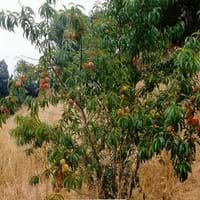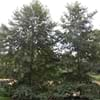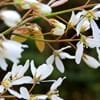Life Span
Perennial
Perennial
Origin
Mid-Atlantic United States, Southeastern United States, Central United States, South-Central United States, Texas
China
Types
Typical Red Buckeye, Yellow-flowered Red Buckeye
Not Available
Number of Varieties
Not Available
Habitat
Shady Edge, Woodland Garden Dappled Shade
Well Drained
USDA Hardiness Zone
5-9
5-9
Sunset Zone
2a, 3a, 3b, 4, 5, 6, 7, 8, 9, 14, 15, 16, 17, 18, 19, 20, 21, 22, 23, 24
H1, 1a, 1b, 2a, 2b, 3a, 3b, 6, 7, 8, 9, 10, 11, 12, 13, 14, 15, 16, 18, 19, 20, 21, 22, 23, 24
Habit
Clump-Forming
Oval or Rounded
Flower Color
Yellow, Red, Orange Red
White, Red, Light Pink
Flower Color Modifier
Bicolor
Bicolor
Fruit Color
Brown
White, Yellow, Red, Pink, Peach
Leaf Color in Spring
Dark Green
Green
Leaf Color in Summer
Dark Green
Green
Leaf Color in Fall
Yellow, Dark Green
Green
Leaf Color in Winter
Not Available
Light Green
Leaf Shape
Elliptic
Lanceolate
Plant Season
Spring, Summer, Fall
Spring, Summer, Fall
Sunlight
Full Sun, Partial Sun, Partial shade
Full Sun
Growth Rate
Medium
Medium
Type of Soil
Clay, Loam
Loam, Sand
The pH of Soil
Acidic, Neutral
Acidic, Neutral
Soil Drainage
Average
Well drained
Tolerances
Not Available
Drought
Where to Plant?
Ground
Ground
How to Plant?
Seedlings
Seedlings
Plant Maintenance
Medium
Medium
Watering Requirements
Average Water Needs, Do Not over Water
Average Water Needs
In Summer
Lots of watering
Lots of watering
In Spring
Moderate
Moderate
In Winter
Average Water
Average Water
Soil pH
Acidic, Neutral
Acidic, Neutral
Soil Type
Clay, Loam
Loam, Sand
Soil Drainage Capacity
Average
Well drained
Sun Exposure
Full Sun, Partial Sun, Partial shade
Full Sun
Pruning
Remove dead branches
Prune in winter, Remove damaged leaves, Remove dead branches, Remove dead leaves
Fertilizers
Apply 10-10-10 amount
All-Purpose Liquid Fertilizer, Apply 15-5-15
Pests and Diseases
Leaf Blotch
Aphids, Caterpillars, Mildew, Red blotch, Scale insects, Susceptible to insect pests and moulds
Plant Tolerance
Drought
Drought, Shade areas
Flower Petal Number
Single
Single
Foliage Texture
Coarse
Medium
Foliage Sheen
Glossy
Glossy
Attracts
Hummingbirds
Birds
Aesthetic Uses
Showy Purposes
Bonsai
Beauty Benefits
Not Available
Not Available
Environmental Uses
Air purification
Air purification
Medicinal Uses
Cancer, Hypnotic, Odontalgic, Salve
Astringent, Bronchitis, Cough, Diuretic, Febrifuge, Gastritis, Laxative
Part of Plant Used
Seeds
Fruits, Leaves
Other Uses
Grounded seed is used as a gruel, Used as a soap substitute
Used for making green dye
Used As Indoor Plant
No
No
Used As Outdoor Plant
Yes
Yes
Garden Design
Feature Plant, Foundation, Mixed Border, Screening / Wind Break
Container, Feature Plant, Fruit / Fruit Tree, Topiary / Bonsai / Espalier
Botanical Name
AESCULUS pavia
PRUNUS persica var. nucipersica
Common Name
Red Buckeye
Nectarine
In Hindi
Red Buckeye
nectarine
In German
Red Buckeye
Nektarine
In French
Red Buckeye
nectarine
In Spanish
rojo castaño de Indias
nectarina
In Greek
κόκκινο Buckeye
νεκταρίνι
In Portuguese
Red Buckeye
nectarina
In Polish
Red Buckeye
nektarowy
In Latin
Red Buckeye
nectarine
Phylum
Magnoliophyta
Tracheophyta
Class
Magnoliopsida
Magnoliopsida
Family
Hippocastanaceae
Rosaceae
Clade
Angiosperms, Eudicots, Rosids
Angiosperms, Eudicots, Rosids
Tribe
Not Available
Not Available
Subfamily
Hippocastanoideae
Not Available
Number of Species
Not Available
Season and Care of Red Buckeye and Nectarine
Season and care of Red Buckeye and Nectarine is important to know. While considering everything about Red Buckeye and Nectarine Care, growing season is an essential factor. Red Buckeye season is Spring, Summer and Fall and Nectarine season is Spring, Summer and Fall. The type of soil for Red Buckeye is Clay, Loam and for Nectarine is Loam, Sand while the PH of soil for Red Buckeye is Acidic, Neutral and for Nectarine is Acidic, Neutral.
Red Buckeye and Nectarine Physical Information
Red Buckeye and Nectarine physical information is very important for comparison. Red Buckeye height is 370.00 cm and width 300.00 cm whereas Nectarine height is 150.00 cm and width 150.00 cm. The color specification of Red Buckeye and Nectarine are as follows:
Red Buckeye flower color: Yellow, Red and Orange Red
Red Buckeye leaf color: Dark Green
Nectarine flower color: White, Red and Light Pink
- Nectarine leaf color: Green
Care of Red Buckeye and Nectarine
Care of Red Buckeye and Nectarine include pruning, fertilizers, watering etc. Red Buckeye pruning is done Remove dead branches and Nectarine pruning is done Prune in winter, Remove damaged leaves, Remove dead branches and Remove dead leaves. In summer Red Buckeye needs Lots of watering and in winter, it needs Average Water. Whereas, in summer Nectarine needs Lots of watering and in winter, it needs Average Water.





